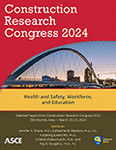A Small-Scale Simulation Approach to Educate the Next Generation of Engineers about Sustainability Challenges in Building Demolition
Publication: Construction Research Congress 2024
ABSTRACT
About 90% of demolition waste is recyclable and reusable based on its inert nature; however, recycling and reuse of those materials are limited. One major barrier is the lack of demolition engineers’ knowledge about sustainable demolition practices. Material separation for recovery at demolition sites is much easier and more effective but more time-consuming than separation for recovery at material recovery facilities. As such, careful demolition planning by construction/demolition engineers is critical; however, most of the US construction engineering curricula do not cover demolition operations, thus lacking learning opportunities about sustainable demolition practices. In an effort to develop the next generation of demolition engineers with the sustainability mindset, we designed small-scale demolition simulation activities using 1:14 scale demolition vehicles where students will be exposed to sustainability challenges (e.g., on-site separation vs. off-site separation) and learned their critical role as construction/demolition engineers. To mimic real-world demolition sites, different structural waste was used, and students would be tasked with operating excavators and trucks in separating and moving different types of materials for recovery within set time constraints. Through the hands-on experience, students could find potential challenges with sustainable operations and develop critical thinking skills to devise solutions and strategies to tackle them.
Get full access to this article
View all available purchase options and get full access to this chapter.
REFERENCES
Adams, K. T., M. Osmani, T. Thorpe, and J. Thornback. 2017. “Circular economy in construction: current awareness, challenges and enablers.” Proceedings of the Institution of Civil Engineers - Waste and Resource Management, 170 (1): 15–24. https://doi.org/10.1680/jwarm.16.00011.
Anumba, C., A. Abdullah, and T. Fesseha. 2003. “Selection of demolition techniques: a case study of the Warren Farm Bridge.” Structural Survey, 21 (1): 36–48. https://doi.org/10.1108/02630800310470853.
Asante, R., D. Faibil, M. Agyemang, and S. A. Khan. 2022. “Life cycle stage practices and strategies for circular economy: assessment in construction and demolition industry of an emerging economy.” Environmental Science and Pollution Research, 29 (54): 82110–82121. https://doi.org/10.1007/s11356-022-21470-w.
Azhar, S., J. Kim, and A. Salman. 2018. Implementing Virtual Reality And Mixed Reality Technologies In Construction Education: Students’ Perceptions And Lessons Learned. 3720–3730.
Bråten, I., and L. E. Ferguson. 2015. “Beliefs about sources of knowledge predict motivation for learning in teacher education.” Teach Teach Educ, 50: 13–23. https://doi.org/10.1016/j.tate.2015.04.003.
Chen, J., M. Wang, and S. Fan. 2013. “Experimental investigation of small-scaled model for powerhouse dam section on shaking table.” Struct Control Health Monit, 20 (5): 740–752. https://doi.org/10.1002/stc.1489.
Collins, W., and L. Redden. 2021. “Improving Student’s Estimating Abilities through Experiential Learning.” Int J Constr Educ Res, 17 (2): 117–132. https://doi.org/10.1080/15578771.2020.1739178.
Effendy, K., T. Octavia, and G. B. Wijaya. 2020. “Usage of Miniature Houses Built using Construction Materials in Engineering Educational Corporate Social Responsibility (CSR) Programs.” International Journal of Industrial Research and Applied Engineering, 5 (2). https://doi.org/10.9744/jirae.5.2.41-48.
Kolb, D. A. 2014. Experiential learning: Experience as the source of learning and development. FT press.
Liu, A., G. Hodgson, and W. Lord. 2010. “Innovation in Construction Education: The Role of Culture in E-learning.” Architectural Engineering and Design Management, 6 (2): 91–102. https://doi.org/10.3763/aedm.2009.0109.
Luciano, A., L. Cutaia, F. Cioffi, and C. Sinibaldi. 2021. “Demolition and construction recycling unified management: the DECORUM platform for improvement of resource efficiency in the construction sector.” Environmental Science and Pollution Research, 28 (19): 24558–24569. https://doi.org/10.1007/s11356-020-09513-6.
Kumaraswamy, M. M., F. Y. Y. Ling, and C. J. Miller. 2007. “Innovative initiatives in construction education and training.” Emirates Journal for Engineering Research, 12 (1): 43–56.
Ngan, S. L., B. S. How, S. Y. Teng, M. A. B. Promentilla, P. Yatim, A. C. Er, and H. L. Lam. 2019. “Prioritization of sustainability indicators for promoting the circular economy: The case of developing countries.” Renewable and Sustainable Energy Reviews, 111: 314–331. https://doi.org/10.1016/j.rser.2019.05.001.
Pittau, F., D. Giacomel, G. Iannaccone, and L. Malighetti. 2020. “Environmental Consequences Of Refurbishment Versus Demolition And Reconstruction: A Comparative Life Cycle Assessment Of An Italian Case Study.” Journal of Green Building, 15 (4): 155–172. https://doi.org/10.3992/jgb.15.4.155.
Reyes, E., and J. C. Gálvez. 2011. “Introduction of Innovations into the Traditional Teaching of Construction and Building Materials.” Journal of Professional Issues in Engineering Education and Practice, 137 (1): 28–37. https://doi.org/10.1061/(ASCE)EI.1943-5541.0000033.
del Río Merino, M., P. Izquierdo Gracia, and I. S. Weis Azevedo. 2010. “Sustainable construction: construction and demolition waste reconsidered.” Waste Management & Research: The Journal for a Sustainable Circular Economy, 28 (2): 118–129. https://doi.org/10.1177/0734242X09103841.
Satterthwait, D. 2010. “Why are’hands-on’science activities so effective for student learning?” Teaching Science, 56 (2): 7–10.
Setareh, M. 2001. “Development of Teaching Tool for Building Construction.” Journal of Architectural Engineering, 7 (1): 6–12. https://doi.org/10.1061/(ASCE)1076-0431(2001)7:1(6).
Shafii, F., Z. A. Ali, and M. Z. Othman. 2006. “Achieving sustainable construction in the developing countries of Southeast Asia.” Proceedings of the 6th Asia-Pacific Structural Engineering and Construction Conference (APSEC 2006), 5–6. Kuala Lumpur, Malaysia.
Whisker, V., S. Yerrapathruni, J. Messner, and A. Baratta. 2003. “Using Virtual Reality To Improve Construction Engineering Education.” Paper presented at 2003 Annual Conference, 8.1266.1–8.1266.9. Nashville, Tennessee: ASEE Conferences.
Wu, S. P. W., and M. A. Rau. 2018. “Effectiveness and efficiency of adding drawing prompts to an interactive educational technology when learning with visual representations.” Learn Instr, 55: 93–104. https://doi.org/10.1016/j.learninstruc.2017.09.010.
Information & Authors
Information
Published In
History
Published online: Mar 18, 2024
ASCE Technical Topics:
- Business management
- Construction engineering
- Construction management
- Construction materials
- Construction methods
- Construction wastes
- Demolition
- Education
- Engineering materials (by type)
- Environmental engineering
- Materials engineering
- Pollutants
- Practice and Profession
- Recycling
- Solid wastes
- Students
- Sustainable development
- Wastes
Authors
Metrics & Citations
Metrics
Citations
Download citation
If you have the appropriate software installed, you can download article citation data to the citation manager of your choice. Simply select your manager software from the list below and click Download.
